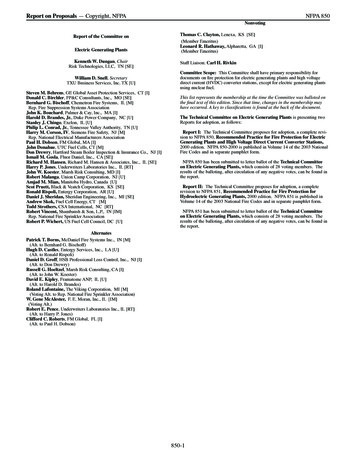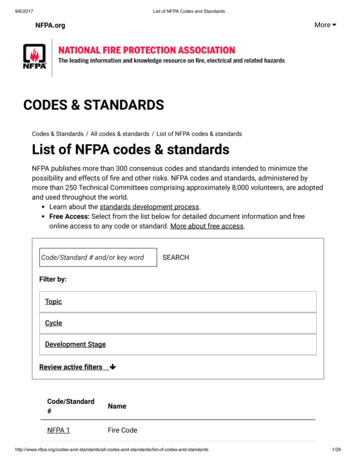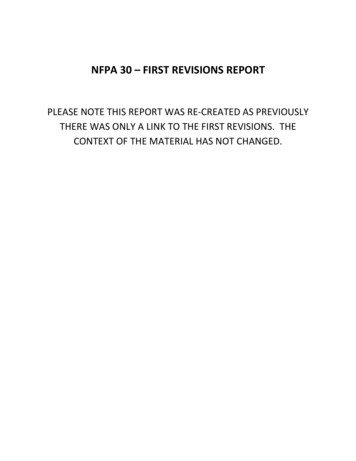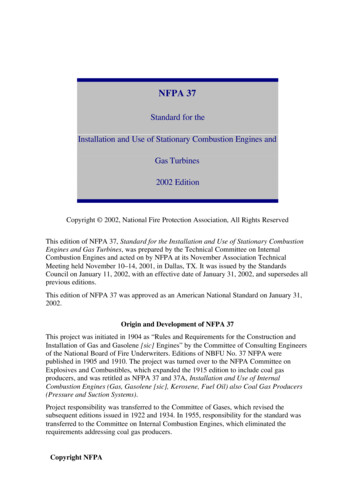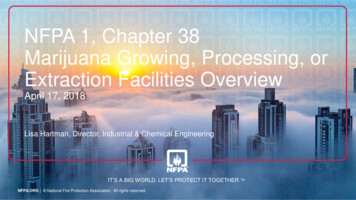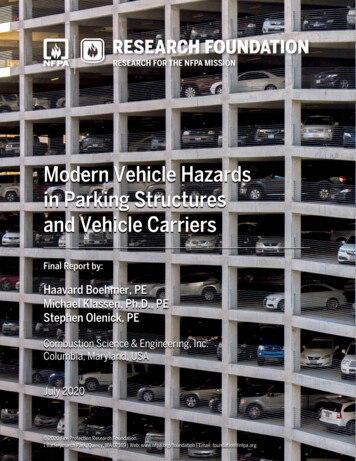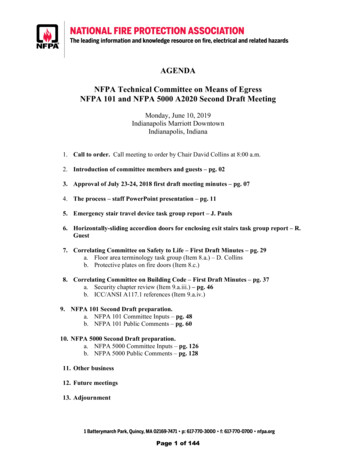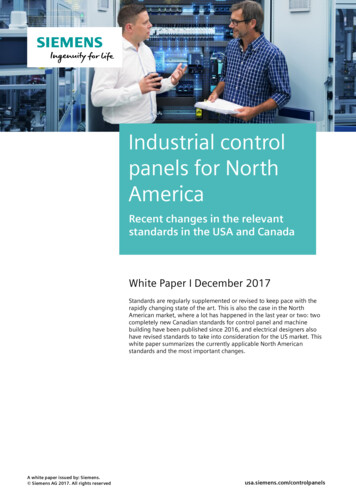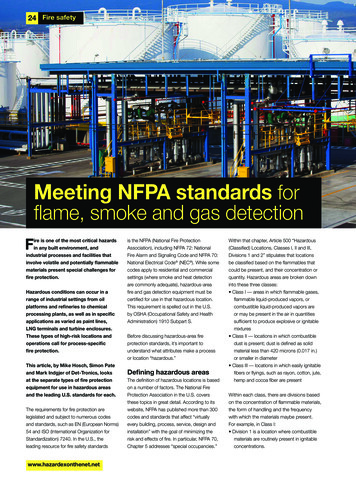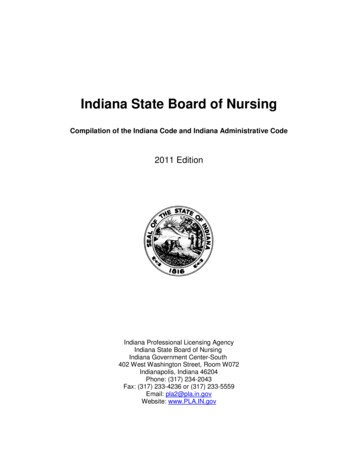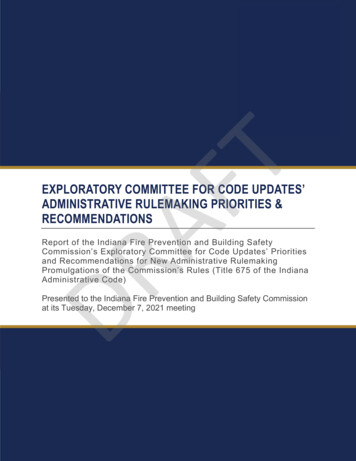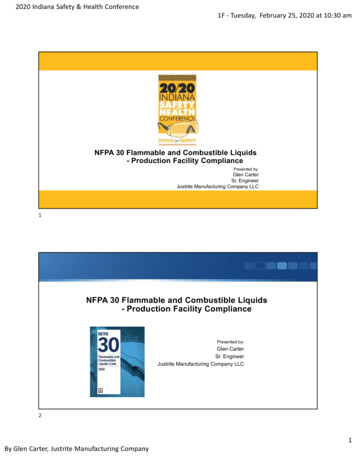
Transcription
2020 Indiana Safety & Health Conference1F ‐ Tuesday, February 25, 2020 at 10:30 amNFPA 30 Flammable and Combustible Liquids- Production Facility CompliancePresented by:Glen CarterSr. EngineerJustrite Manufacturing Company LLC1NFPA 30 Flammable and Combustible Liquids- Production Facility CompliancePresented by:Glen CarterSr. EngineerJustrite Manufacturing Company LLC21By Glen Carter, Justrite Manufacturing Company
2020 Indiana Safety & Health Conference1F ‐ Tuesday, February 25, 2020 at 10:30 amPreface Notes:Disclaimers:1)Any opinions expressed in this presentation do not necessarily represent theposition of NFPA or any of its Technical Committees.2)Some sections are reproduced with permission of NFPA from NFPA 30,Flammable and Combustible Liquids Code, 2018 edition. Copyright 2017,National Fire Protection Association. For a full copy of NFPA 30, please go towww.nfpa.org.3) 2017 NFPA, reproduced with permission. This presentationand/or publication is not affiliated with or approved by the NFPA3NFPA 30 Flammable and Combustible Liquids- Production Facility CompliancePresented by:Glen CarterSr. EngineerJustrite Manufacturing Company LLC42By Glen Carter, Justrite Manufacturing Company
2020 Indiana Safety & Health Conference1F ‐ Tuesday, February 25, 2020 at 10:30 amFlash Point ClassificationFlash Point is:Lowest temperature at whichsufficient vapor is given off toform ignitable mixture w/air5Flash Point ClassificationNFPA 30 Manages Risk Of FlammableAnd Combustible Liquids By Their FlashPoint ClassificationThere are two classifications systems you need tobe aware of: NFPA 30 section 4.3.1 (flammable liquids) & 4.3.2 (combustible liquids) OSHA 29CFR 1910.106(a)(19) Per GHS Labeling & GHS Safety Data Sheet (SDS) It is important to cross reference from the labels/SDSsheets of material received into NFPA 30’s classificationto apply the NFPA 30 Code, NFPA 1 Code etc. 63By Glen Carter, Justrite Manufacturing Company
2020 Indiana Safety & Health Conference1F ‐ Tuesday, February 25, 2020 at 10:30 am784By Glen Carter, Justrite Manufacturing Company
2020 Indiana Safety & Health Conference1F ‐ Tuesday, February 25, 2020 at 10:30 amFlash Point Classification9VaporVapor : Not liquid that burns it’s vapors w/air Vapor density of most flammables is heavier than air Proportional to Surface Area Pressure increases w/temperature105By Glen Carter, Justrite Manufacturing Company
2020 Indiana Safety & Health Conference1F ‐ Tuesday, February 25, 2020 at 10:30 amAcceptable Containers11Acceptable ContainersOpen containersviolates OSHA andthe EPA126By Glen Carter, Justrite Manufacturing Company
2020 Indiana Safety & Health Conference1F ‐ Tuesday, February 25, 2020 at 10:30 amAcceptable Containers13Acceptable Containers147By Glen Carter, Justrite Manufacturing Company
2020 Indiana Safety & Health Conference1F ‐ Tuesday, February 25, 2020 at 10:30 amAcceptable ContainersQuick Note:1) Gasoline has traditionally been a Class 1B flammable liquidbut, with some of the newer oil extraction techniques andformulation, gasoline can be a Class 1A flammable liquid. Checkyour SDS sheet. Meaning you might need a maximum 2.6 gallonsafety can maximum instead of 5.3 gallon maximum.2) A 2 gallons maximum safety can is allowed per OSHA’sCategory 1 (Class 1A - NFPA).(using maximum 2.6 gallons safety cans would likely be considered de minimisper OSHA.)15Acceptable Containers9.4 Acceptable Containers.3) Nonmetallic or metallic commercial/industrial safetycans meeting the requirements of, and used within thescope of, one or more of the following specifications:(a) ANSI/UL 30, Standard for Metal Safety Cans(b) ANSI/UL 1313, Standard for Nonmetallic Safety Cans forPetroleum Products(c) FM Global Approval Standard for Safety Containers andFilling, Supply, and Disposal Containers —Class Number 6051 and 6052168By Glen Carter, Justrite Manufacturing Company
2020 Indiana Safety & Health Conference1F ‐ Tuesday, February 25, 2020 at 10:30 amSafety Cans3.3.49* Safety Can. A listed container of not more than5.3 gal (20 L) capacity having a screen or strainer ineach fill and pour opening and having a spring-closing lidand spout cover designed to safely relieve internalpressure when exposed to fire.to fire.17Safety Cans189By Glen Carter, Justrite Manufacturing Company
2020 Indiana Safety & Health Conference1F ‐ Tuesday, February 25, 2020 at 10:30 amSafety Cans3.3.49* Safety Can. A listed container of not more than5.3 gal (20 L) capacity having a screen or strainer ineach fill and pour opening and having a spring-closing lidand spout cover designed to safely relieve internalpressure when exposed to fire.19Oily Waste(Auto) Ignition Temperature:1) Minimum temperature of heat source2)to ignite vaporIs the lowest temperature at which amass will spontaneously combust2010By Glen Carter, Justrite Manufacturing Company
2020 Indiana Safety & Health Conference1F ‐ Tuesday, February 25, 2020 at 10:30 amOily WasteOily Rags Are DangerousNFPA Statistic: One-quarter of the firesin manufacturing properties began withoily rags.21Oily WasteNFPA 30 6.9.3 or 21.6.6.5 or 24.16.1Combustible waste material and residuesin operating areas shall be kept to aminimum, stored in covered metalcontainers, and disposed of dailyNFPA 30A9.7.9.5 Approved metal receptacles withself-closing covers shall be provided for thestorage or disposal of oil-soaked waste orcloths.9.7.9.6 Combustible rubbish shall beplaced in covered metal receptacles untilremoved to a safe place for disposal.Contents of such containers shall beremoved daily.2211By Glen Carter, Justrite Manufacturing Company
2020 Indiana Safety & Health Conference1F ‐ Tuesday, February 25, 2020 at 10:30 amOily WasteOne Meridian PlazaPhiladelphiaORX 1023Oily WasteEMPTY EVERY NIGHTBut, where?2412By Glen Carter, Justrite Manufacturing Company
2020 Indiana Safety & Health Conference1F ‐ Tuesday, February 25, 2020 at 10:30 amFlammable Liquids Storage Cabinets(Auto) Ignition Temperature:1) Minimum temperature of heat source2)to ignite vaporIs the lowest temperature at which amass will spontaneously combust25Flammable Liquids Storage Cabinets2613By Glen Carter, Justrite Manufacturing Company
2020 Indiana Safety & Health Conference1F ‐ Tuesday, February 25, 2020 at 10:30 amFlammable Liquids Storage Cabinets9.5* Flammable Liquids Storage Cabinets.9.5.3 Storage cabinets that meet at least one ofthe following sets of requirements shall beacceptable for storage of liquids:(1) Storage cabinets designed and constructedto limit the internal temperature at the centerof the cabinet and 1 in. (25 mm) from the topof the cabinet to not more than 325 F(163 C), when subjected to a 10-minute firetest that simulates the fire exposure of thestandard time– temperature curve specifiedin ASTM E119, Standard Test Methods forFire Tests of Building Construction andMaterials, shall be acceptable. All joints andseams shall remain tight and the door shallremain securely closed during the test.And/Or constructed as follows27Flammable Liquids Storage CabinetsQuick note on maximum 325 F :1. Typical auto ignition temperatures of flammable & combustibleliquids: ethanol 689 F, gasoline 475 F (246 C), jet fuel 410 F (210 C) , kerosene 428 F (220 C), methyl alcohol 867 F(462 C) etc 2. Auto ignition outlier* of Carbon Disulfide at 194 F (90 C)2814By Glen Carter, Justrite Manufacturing Company
2020 Indiana Safety & Health Conference1F ‐ Tuesday, February 25, 2020 at 10:30 amFlammable Liquids Storage Cabinets9.5* Flammable Liquids Storage Cabinets.Metal storage cabinets constructed in thefollowing manner shall be acceptable:(a) The bottom, top, door, and sides of thecabinet shall be at least No. 18 gauge sheetsteel and shall be double-walled, with 1 1/2in. (38 mm) air space.(b) Joints shall be riveted, welded, or madetight by some equally effective means.(c) The door shall be provided with a threepoint latch arrangement, and the door sillshall be raised at least 2 in. (50 mm) abovethe bottom of the cabinet to retain spilledliquid within the cabinet.And/or constructed as follows29Flammable Liquids Storage CabinetsVenting a Safety Cabinet9.5.4* Storage cabinets shall not be required by this code tobe ventilated for fire protection purposes.9.5.4.1 If a storage cabinet is not ventilated, the ventopenings shall be sealed with the bungs supplied with thecabinet or with bungs specified by the cabinet manufacturer.9.5.4.2* If a storage cabinet is ventilated for any reason, thevent openings shall be ducted directly to a safe locationoutdoors or to a treatment device designed to controlvolatile organic compounds (VOCs) and ignitable vapors insuch a manner that will not compromise the specifiedperformance of the cabinet and in a manner that isacceptable to the authority having jurisdiction.3015By Glen Carter, Justrite Manufacturing Company
2020 Indiana Safety & Health Conference1F ‐ Tuesday, February 25, 2020 at 10:30 amFlammable Liquids Storage CabinetsVenting a Safety Cabinet31Flammable Liquids Storage CabinetsVenting a Safety CabinetA.9.5.4 Venting of storage cabinets has not been demonstrated to be necessary forfire protection purposes. Additionally, venting a cabinet could compromise the abilityof the cabinet to adequately protect its contents from involvement in a fire, becausecabinets are not generally tested with any venting. Therefore, venting of storagecabinets is not recommended.However, it is recognized that some jurisdictions might require storage cabinets to bevented and that venting can also be desirable for other reasons, such as health andsafety. In such cases, the venting system should be installed so as to not affectsubstantially the desired performance of the cabinet during a fire. Means ofaccomplishing this can include thermally actuated dampers on the vent openings orsufficiently insulating the vent piping system to prevent the internal temperature of thecabinet from rising above that specified. Any make-up air to the cabinet should alsobe arranged in a similar manner.If vented, the cabinet should be vented from the bottom with make-up air supplied tothe top. Also, mechanical exhaust ventilation is preferred and should comply withNFPA 91. Manifolding the vents of multiple storage cabinets should be avoided.3216By Glen Carter, Justrite Manufacturing Company
2020 Indiana Safety & Health Conference1F ‐ Tuesday, February 25, 2020 at 10:30 amFlammable Liquids Storage CabinetsVenting a Safety CabinetMy recommendations:1. Retain a professional engineer.2. Consult with the AHJs.3. Planning/design should consider the possible conveyance of: ignitable vapors, ignitablegases, or ignitable dust based on material being stored.4. Cabinet bungs accommodate 2” NPT threaded schedule 40 steel pipe for ductwork.5. Use black steel, galvanized steel or stainless steel schedule 40 steel pipe6. Avoid PVC, CPVC. ABS, Polypropylene pipe etc.7. Ground vented safety cabinet and duct work when required.8. Evacuate vapors from the cabinet using negative pressure (suction).9. An air exchange of 1 ft3/min/ft2 (5.1 L/s/m2) of floor area is recommended10. Blowers should be specified for hazardous locations as required by the material stored.(Electrical equipment: Class 1 Division 2, Art 500 of NFPA 70)11. Blowers should shut down in the events of a fire.12. Most flammable vapors are heavier than air, draw from the bottom. bung and providefresh air through the top bung.33Flammable Liquids Storage CabinetsVenting a Safety Cabinet1) Reference these codes and standards for properventilation design:a. NFPA 91 Standard for Exhaust Systems for AirConveying of Vapors, Gases, Mists, and ParticulateSolidsb. NFPA 70 National Electrical Code (see chapter 5Special occupancies)c. NFPA 77 Recommended Practice on StaticElectricityd. NFPA 45 Chapter 7 Laboratory VentilatingSystems and Hood Requirementse. ANSI/AIHA Z9.5 – 2012 Laboratory Ventilation3417By Glen Carter, Justrite Manufacturing Company
2020 Indiana Safety & Health Conference1F ‐ Tuesday, February 25, 2020 at 10:30 amFlammable Liquids Storage CabinetsNFPA 30 - Flammable and CombustibleLiquids CodeFLAMMABLE LIQUIDSTORAGE CABINETNFPA 400 – HazardousMaterial Code35Flammable Liquids Storage Cabinets9.5* Flammable Liquids Storage Cabinets.9.5.1 The volume of Class I, Class II, and Class IIIA liquids stored in anindividual storage cabinet shall not exceed 120 gal (460 L).3618By Glen Carter, Justrite Manufacturing Company
2020 Indiana Safety & Health Conference1F ‐ Tuesday, February 25, 2020 at 10:30 amFlammable Liquids Storage Cabinets1910.106(d)(3)"Design, construction, and capacity of storage cabinets" i) Maximum capacity. Not more than 60 gallons of Category 1, 2, or 3flammable liquids, nor more than 120 gallons of Category 4 flammableliquids may be stored in a storage cabinet.37Incompatible Materials9.17 Separation from Incompatible Materials.9.17.1.1 Separation shall be accomplished by one of the followingmethods:(1) Segregating incompatible materials storage by a distance ofnot less than 20 ft (6.1 m)(2) Isolating incompatible materials storage by a noncombustiblepartition extending not less than 18 in. (460 mm) above and tothe sides of the stored materials(3) Storing liquid materials in flammable liquids storage cabinetsin accordance with Section 9.59.17.3 Flammable and combustible liquids shall be separated fromoxidizers by at least 25 ft (7.6 m).3819By Glen Carter, Justrite Manufacturing Company
2020 Indiana Safety & Health Conference1F ‐ Tuesday, February 25, 2020 at 10:30 amMaximum Allowable Quantities9.6 Maximum Allowable Quantities (MAQs) per Control Area.Δ 9.6.1 General Occupancy Limits. The maximum allowablequantities (MAQs) of liquids allowed in each control area shall not exceedthe amounts specified in Table 9.6.1.on9.6.2 Special Occupancy Limits.9.6.2.1 For the following occupancies, the MAQs per controlarea shall not exceed the amounts specified in Table 9.6.2.1:(1) Assembly(2) Ambulatory health care(3) Business(4) Day care(5) Detention and correctional(6) Educational(7) Health care(8) ResidentialReference: Section 9.7 Control Areas39MaximumAllowableQuantitiesReference:Section 9.7Control Areas4020By Glen Carter, Justrite Manufacturing Company
2020 Indiana Safety & Health Conference1F ‐ Tuesday, February 25, 2020 at 10:30 amMaximum Allowable QuantitiesReference: Section 9.7 Control Areas41Chapter 14 HazardousMaterials Storage Lockers4221By Glen Carter, Justrite Manufacturing Company
2020 Indiana Safety & Health Conference1F ‐ Tuesday, February 25, 2020 at 10:30 amChapter 14 HazardousMaterials Storage Lockers43Chapter 14HazardousMaterialsStorageLockers4422By Glen Carter, Justrite Manufacturing Company
2020 Indiana Safety & Health Conference1F ‐ Tuesday, February 25, 2020 at 10:30 amChapter 14 HazardousMaterials Storage Lockers9.16 Explosion Control.Δ 9.16.1* Where Class IA liquids are stored in containerslarger than 1 gal (4 L), areas shall be provided with ameans of explosion control that meets the requirementsof NFPA 69. An approved engineered damage limitingconstruction design shall also be permitted.Exception: This does not apply to a liquid storage roomtotally enclosed within a building.See: NFPA 69 Standard on Explosion Prevention Systems45Ignition Sources6.5 Control of Ignition Sources.6.5.1 General. Precautions shall be taken to preventthe ignition of flammable vapors by sources such asthe following:Reference:(1) Open flames (2) Lightning(3) Hot surfaces (4) Radiant heat(5) Smoking (6) Cutting and welding (7) Spontaneous ignition(8)* Frictional heat or sparks(9) Static electricity(10) Electrical sparks(11) Stray currents(12) Ovens, furnaces, and heating equipmentNFPA 51B Standard for FirePrevention During Welding,Cutting, and Other Hot WorkNFPA 70 National ElectricalCode - Article 500 HazardousLocationNFPA 77 RecommendedPractice on Static Electricity4623By Glen Carter, Justrite Manufacturing Company
2020 Indiana Safety & Health Conference1F ‐ Tuesday, February 25, 2020 at 10:30 amHot SurfacesLet equipment coolbefore fueling47Always properly ground or bondNFPA 30 - Static Electricity.3.3.7 Bonding. For the purpose of controlling static electric hazards, the processof connecting two or more conductive objects together by means of a conductorso that they are at the same electrical potential, but not necessarily at the samepotential as the earth. [77, 2014]3.3.23 Grounding. The process of bonding one or more conductive objects tothe ground, so that all objects are at zero (0) electrical potential; also referred toas earthing. [77, 2014]6.5.4.1 All equipment such as tanks, machinery, and piping shall be designedand operated to prevent electrostatic ignitions.See: NFPA 77 Recommended Practice on Static Electricity4824By Glen Carter, Justrite Manufacturing Company
2020 Indiana Safety & Health Conference1F ‐ Tuesday, February 25, 2020 at 10:30 amAlways properly ground or bondVerla cosmetics factory explosion:1 man was killed, 125 were injured49Always properly ground or bondNFPA 30 - Static Electricity.18.5 Incidental Operations.18.5.1* This section shall apply to areas where the use, handling, and storage of liquids isonly a limited activity to the established occupancy classification.18.5.2 Class I liquids or Class II and Class III liquids that are heated up to or above theirflash points shall be drawn from or transferred into vessels, containers, or portable tanks asfollows:(1) From original shipping containers with a capacity of 5.3 gal (20 L) or less(2) From safety cans(3) Through a closed piping system(4) From portable tanks or containers by means of a device that has antisiphoningprotection and that draws through an opening in the top of the tank or container(5) By gravity through a listed self-closing valve or self-closing faucet18.5.2.1 If hose is used in the transfer operation, it shall be equipped with a self-closingvalve without a hold-open latch in addition to the outlet valve. Only listed or approved hoseshall be used.18.5.2.2 Means shall be provided to minimize generation of static electricity. Such meansshall meet the requirements of 6.5.4.5025By Glen Carter, Justrite Manufacturing Company
2020 Indiana Safety & Health Conference1F ‐ Tuesday, February 25, 2020 at 10:30 amAlways properly ground or bond51Always properly ground or bondType I Safety CansDispensingType II Safety CansDispensingType I or Type II Filling5226By Glen Carter, Justrite Manufacturing Company
2020 Indiana Safety & Health Conference1F ‐ Tuesday, February 25, 2020 at 10:30 amAlways properly ground or bondNFPA 70 ARTICLE 250 - Grounding and Bonding53Always properly ground or bond& InsideOutsideWhen dispensing fluids fromcontainers inside a cabinet alwaysground the cabinet too5427By Glen Carter, Justrite Manufacturing Company
2020 Indiana Safety & Health Conference1F ‐ Tuesday, February 25, 2020 at 10:30 amSelf-closing Faucet18.5 Incidental Operations.listed self-closing valve or self-closing faucetFM approved self closing faucetNot ThisThis55Emergency Relief Vent3.3.61 Vent.3.3.61.1 Emergency Relief Vent. An opening, construction method, ordevice that will automatically relieve excessive internal pressure due to anexposure fire.5628By Glen Carter, Justrite Manufacturing Company
2020 Indiana Safety & Health Conference1F ‐ Tuesday, February 25, 2020 at 10:30 amEmergency Relief Vent3.3.61 Vent.3.3.61.1 Emergency Relief Vent. An opening, construction method, ordevice that will automatically relieve excessive internal pressure due to anexposure fire.57Combustible WasteNFPA 306.9.3 Combustible waste material and residues inoperating areas shall be kept to a minimum, stored incovered metal containers, and disposed of daily.NFPA 30A9.7.9.6 Combustible rubbish shall be placed in coveredmetal receptacles until removed to a safe place fordisposal. Contents of such containers shall be removeddaily.5829By Glen Carter, Justrite Manufacturing Company
2020 Indiana Safety & Health Conference1F ‐ Tuesday, February 25, 2020 at 10:30 amSpill Control59Spill Control6030By Glen Carter, Justrite Manufacturing Company
2020 Indiana Safety & Health Conference1F ‐ Tuesday, February 25, 2020 at 10:30 amSpill Control9.4.3.4 Leaking or damaged containers up to 60 gal (230 L)capacity shall be permitted to be stored temporarily in accordancewith this chapter and Chapters 10 through 12, providedthey are enclosed in overpack containers.61Spill Control9.13* Containment, Drainage, and Spill Control.9.13.1 Storage areas shall be designed and operated toprevent the discharge of liquids to public waterways, public sewers, oradjoining property, unless such discharge has been specificallyapproved.18.4.2 Where liquids are used or handled, provisions shall be made topromptly and safely mitigate and dispose of leakage or spills.6231By Glen Carter, Justrite Manufacturing Company
2020 Indiana Safety & Health Conference1F ‐ Tuesday, February 25, 2020 at 10:30 amSpill ControlAlso reference:EPA 40 CFR 264.175 ContainmentEPA 40 CFR Chapter I, Subchapter D, Part 112 Oil Pollution Prevention, Spill Prevention,Control And Countermeasures (SPCC)OSHA CFR 29 1910.120 Hazardous waste operations and emergency response.NFPA 472 - "Standard for Professional Competence of Responders to Hazardous MaterialIncidents“NFPA 471 - "Recommended Practice for Responding to Hazardous MaterialIncidents"63Contact:Justrite Manufacturing Company LLC:Glen Cartergcarter@justritemfg.com(217) 238-5015www.justrite.com6432By Glen Carter, Justrite Manufacturing Company
Flammable Liquids Storage Cabinets Flammable Liquids Storage Cabinets Quick note on maximum 325 F : 1. Typical auto ignition temperatures of flammable & combustible liquids: ethanol 689 F, gasoline 475 F (246 C), jet fuel 410 F (210 C) , kerosene 428 F (220 C), methyl alcohol 867 F (462 C) etc 2.
